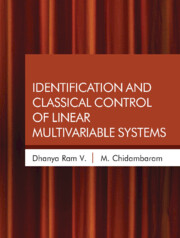Book contents
- Frontmatter
- Contents
- Preface
- Acknowledgements
- List of Abbreviations
- Notations
- 1 Models, Control Theory, and Examples
- 2 Identification and Control of SISO Systems
- 3 Introduction to Linear Multivariable Systems
- 4 CRC Method for Identifying TITO Systems
- 5 CRC Method for Identifying SISO Systems by CSOPTD Models
- 6 CRC Method for Identifying TITO Systems by CSOPTD Models
- 7 Identification of StableMIMO System by Optimization Method
- 8 Identification of Centralized ControlledMultivariable Systems
- 9 Identification of Multivariable SOPTD Models by Optimization Method
- 10 Identification of Unstable TITO Systems by Optimization Technique
- 11 Centralized PI Controllers Based on Steady State Gain Matrix
- 12 SSGM Identification and Control of Unstable Multivariable Systems
- 13 Control of Stable Non-square MIMO Systems
- 14 Control of Unstable Non-square Systems
- 15 Trends in Control ofMultivariable Systems
- Appendix A Identification of Unstable Second Order Transfer Function Model with a Zero by Optimization Method
- Appendix B For Chapter 3
- Appendix C For Chapter 7
- Bibliography
- Index
4 - CRC Method for Identifying TITO Systems
Published online by Cambridge University Press: 31 July 2022
- Frontmatter
- Contents
- Preface
- Acknowledgements
- List of Abbreviations
- Notations
- 1 Models, Control Theory, and Examples
- 2 Identification and Control of SISO Systems
- 3 Introduction to Linear Multivariable Systems
- 4 CRC Method for Identifying TITO Systems
- 5 CRC Method for Identifying SISO Systems by CSOPTD Models
- 6 CRC Method for Identifying TITO Systems by CSOPTD Models
- 7 Identification of StableMIMO System by Optimization Method
- 8 Identification of Centralized ControlledMultivariable Systems
- 9 Identification of Multivariable SOPTD Models by Optimization Method
- 10 Identification of Unstable TITO Systems by Optimization Technique
- 11 Centralized PI Controllers Based on Steady State Gain Matrix
- 12 SSGM Identification and Control of Unstable Multivariable Systems
- 13 Control of Stable Non-square MIMO Systems
- 14 Control of Unstable Non-square Systems
- 15 Trends in Control ofMultivariable Systems
- Appendix A Identification of Unstable Second Order Transfer Function Model with a Zero by Optimization Method
- Appendix B For Chapter 3
- Appendix C For Chapter 7
- Bibliography
- Index
Summary
In this chapter, a Closed Loop Reaction (CRC) curvemethod for the identification of stable TITO system is discussed. The system under consideration is controlled by decentralized PI or PID controllers. The responses and interactions are modelled by the extension of Yuwana and Seborg (1982) method and the transfer function matrix for the closed loop system is obtained. Using the relation between the open loop and the closed loop transfer function matrices, the open loop transfer function matrix is obtained in Laplace (s) domain. The responses of the obtained and the actual transfer functions matrix with the original controller settings are compared. Better results are obtained if the parameters of the identified transfer function models are used as initial guess values for any optimization method and the transfer function model is identified. The higher order models are approximated to a FOPTD model. Since the method is proposed for stable systems,many of the higher order stable systems can be approximated to a FOPTD system.
Identification Method
Identification of Individual Responses
Consider a stable 2 × 2 transfer function matrix (GP ) as in Eq. (4.1a).
Let the controller settings be defined by the matrix given in Eq. (4.2).
The PI/PID controllers are selected so as to get a closed loop under-damped response. Initial controller settings are taken, based on the knowledge of the gain alone, using Davison method (Section 3.13).
Consider Fig. 4.1a. A step change of known magnitude is given to the set point yr1 and the other set point is kept unchanged. The main response obtained is y11 and the interaction response is y21. Similarly for Fig. 4.1b. A step change of the same magnitude is given as yr2 and the other set point is kept unchanged. Let the set point matrix be given as in Eq. (4.3).
The main response is denoted as y22, the interaction as y21, and the output matrix is given in Eq. (4.4).
The transfer function of the closed loop responses is assumed to be an under-damped SOPTD system. From the closed loop response curve for each case, the values yp1, yp2, ym1 and T are noted (Fig. 2.6). Using the formulas given by Yuwana and Seborg (1982), the value of τe and ζ are noted for each case. The closed loop time delay is noted from the responses.
- Type
- Chapter
- Information
- Publisher: Cambridge University PressPrint publication year: 2023

